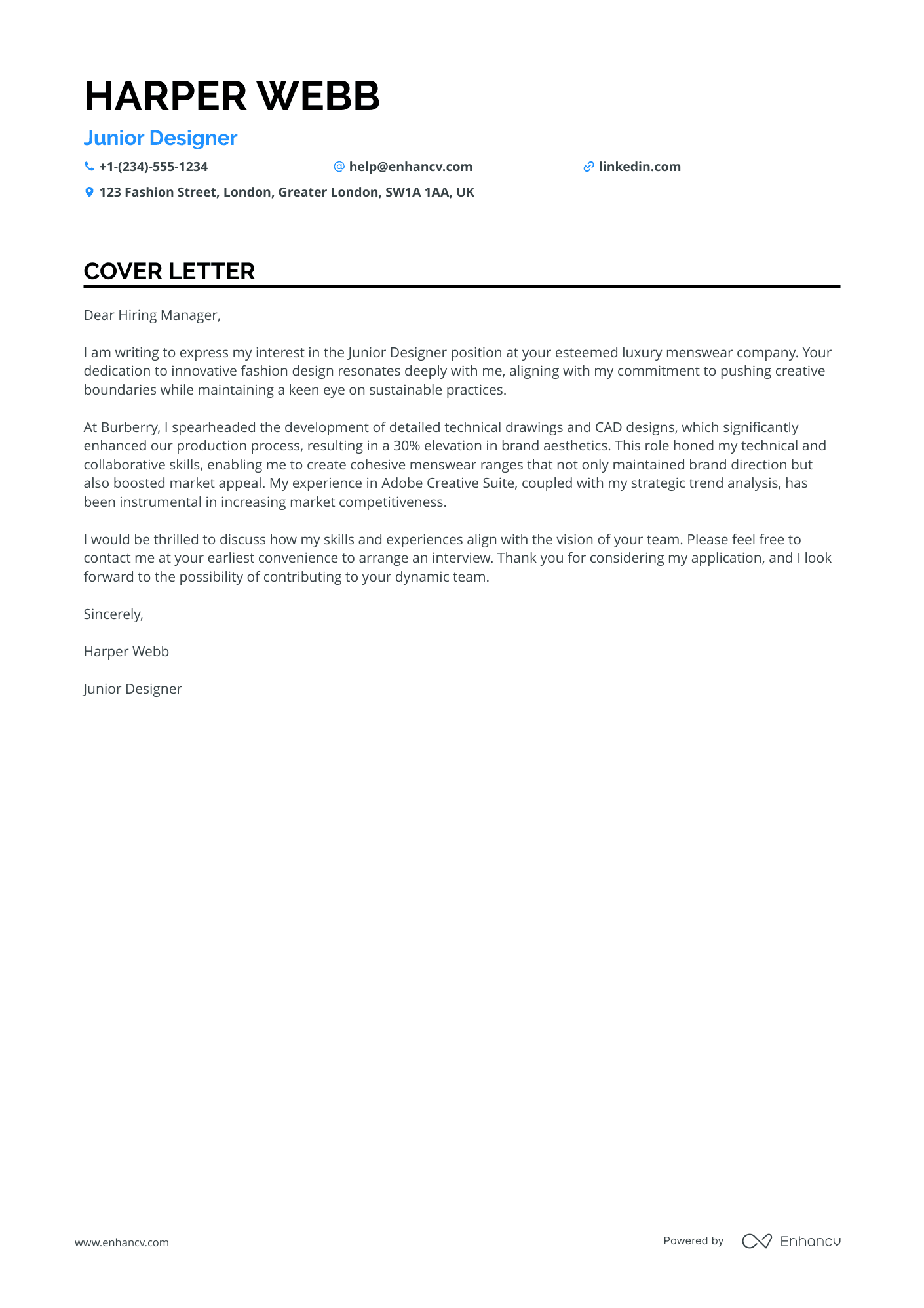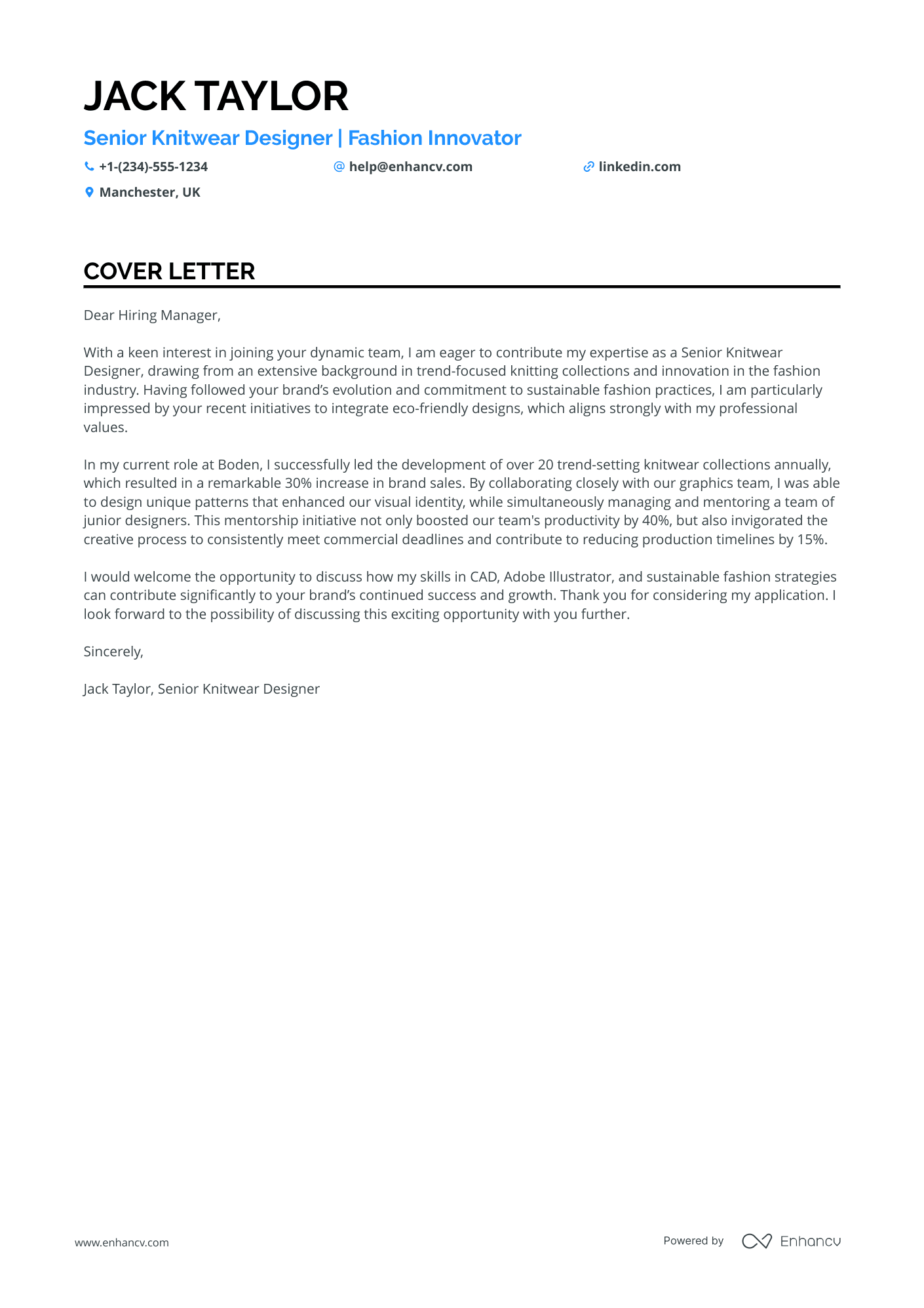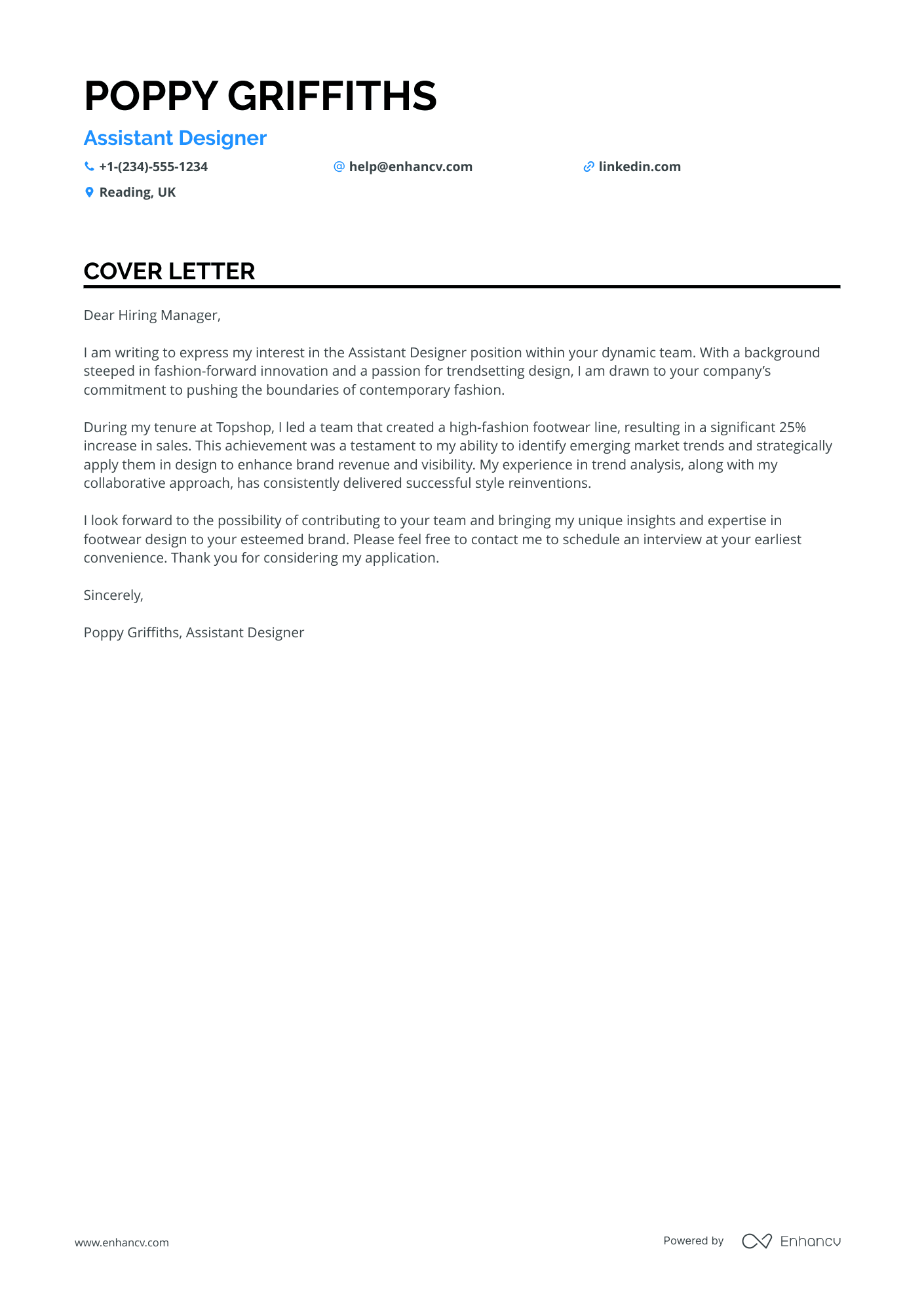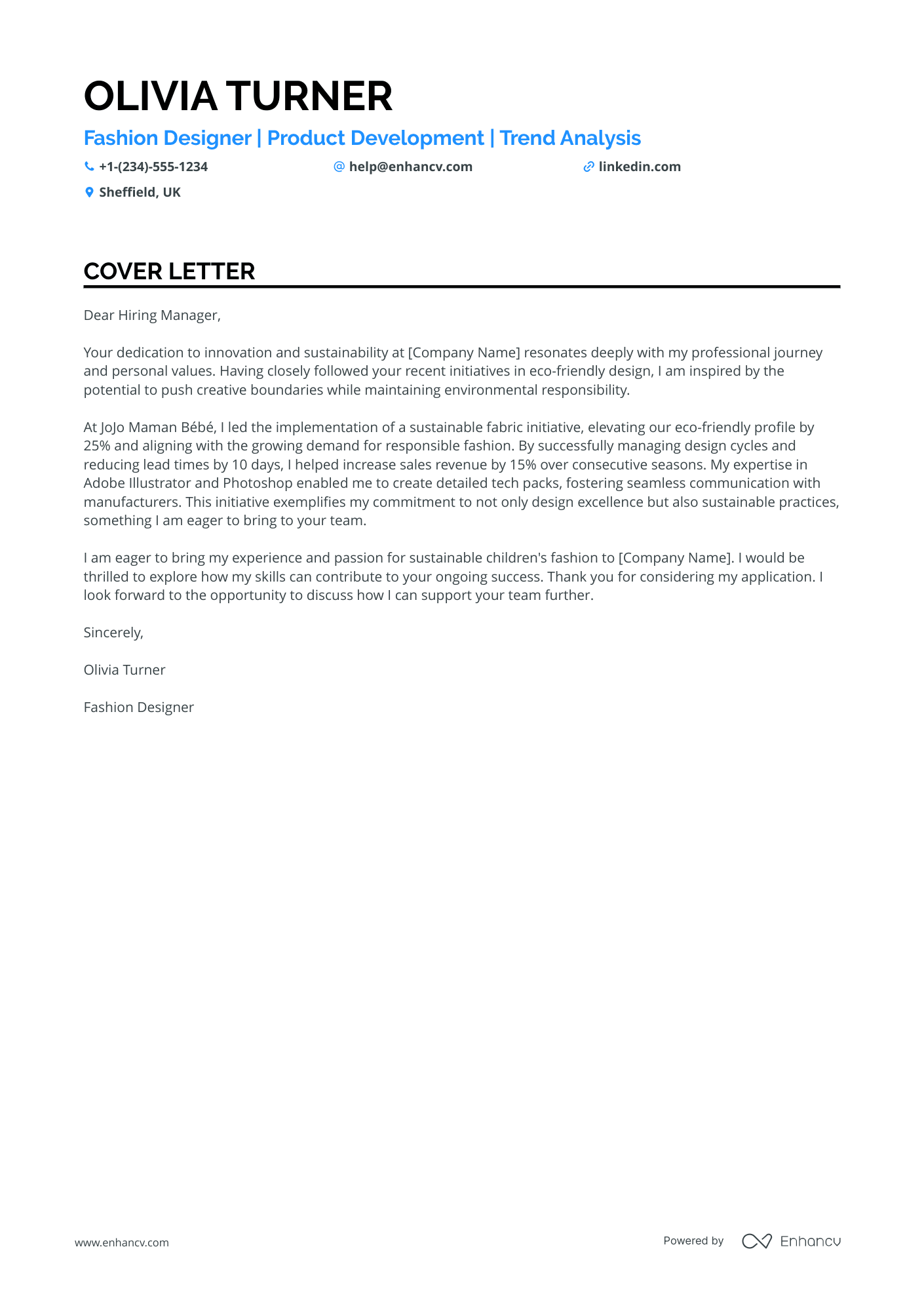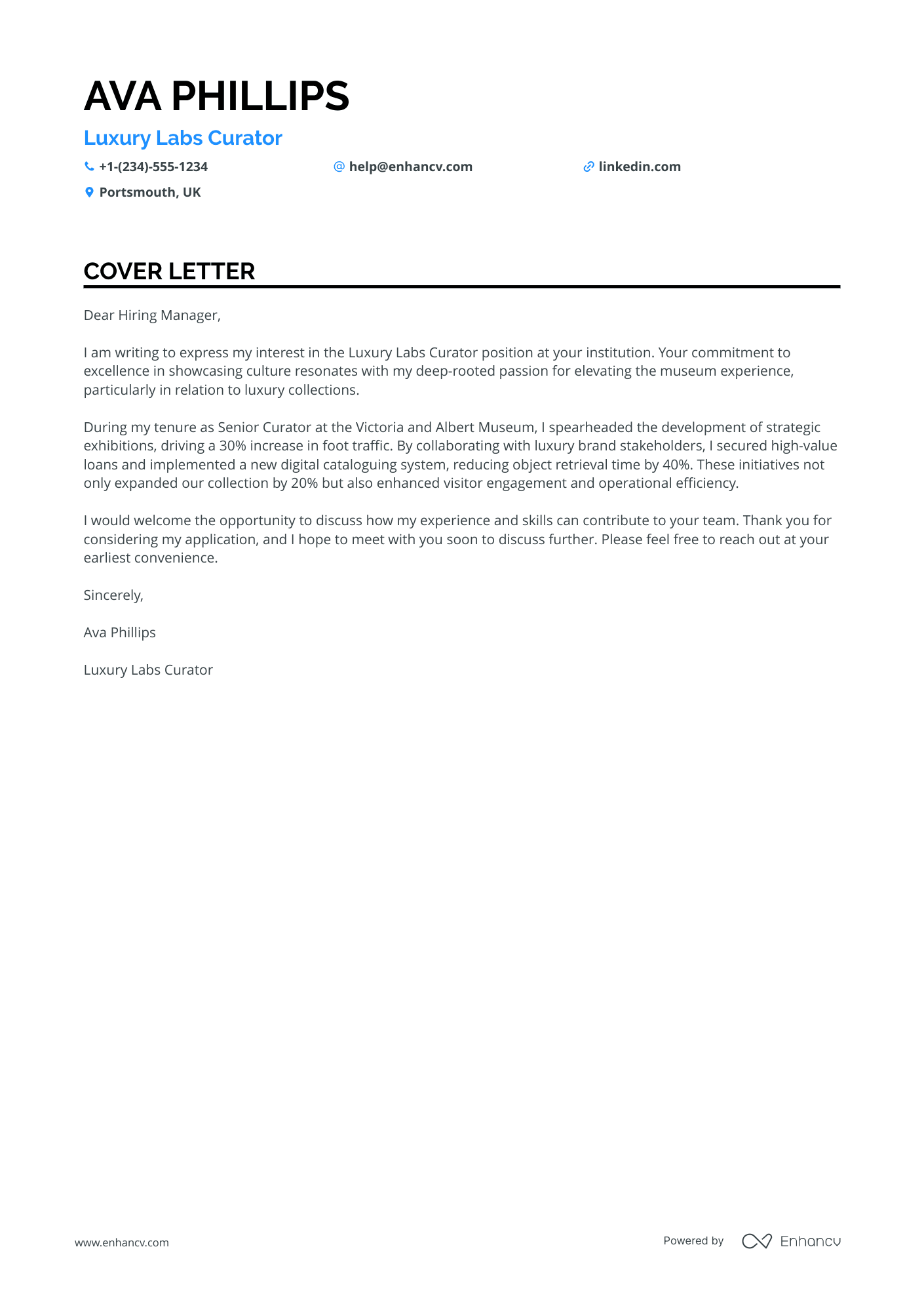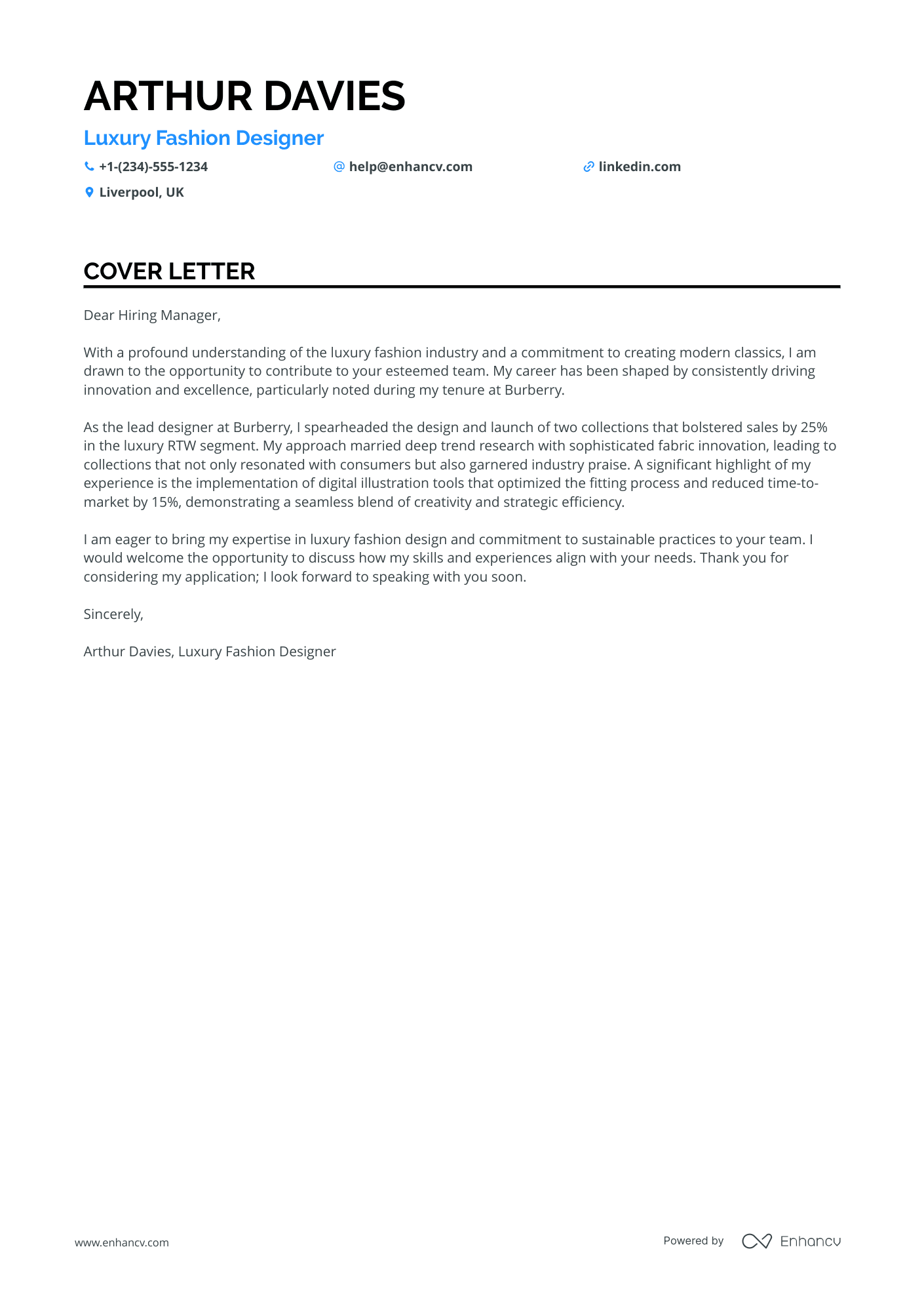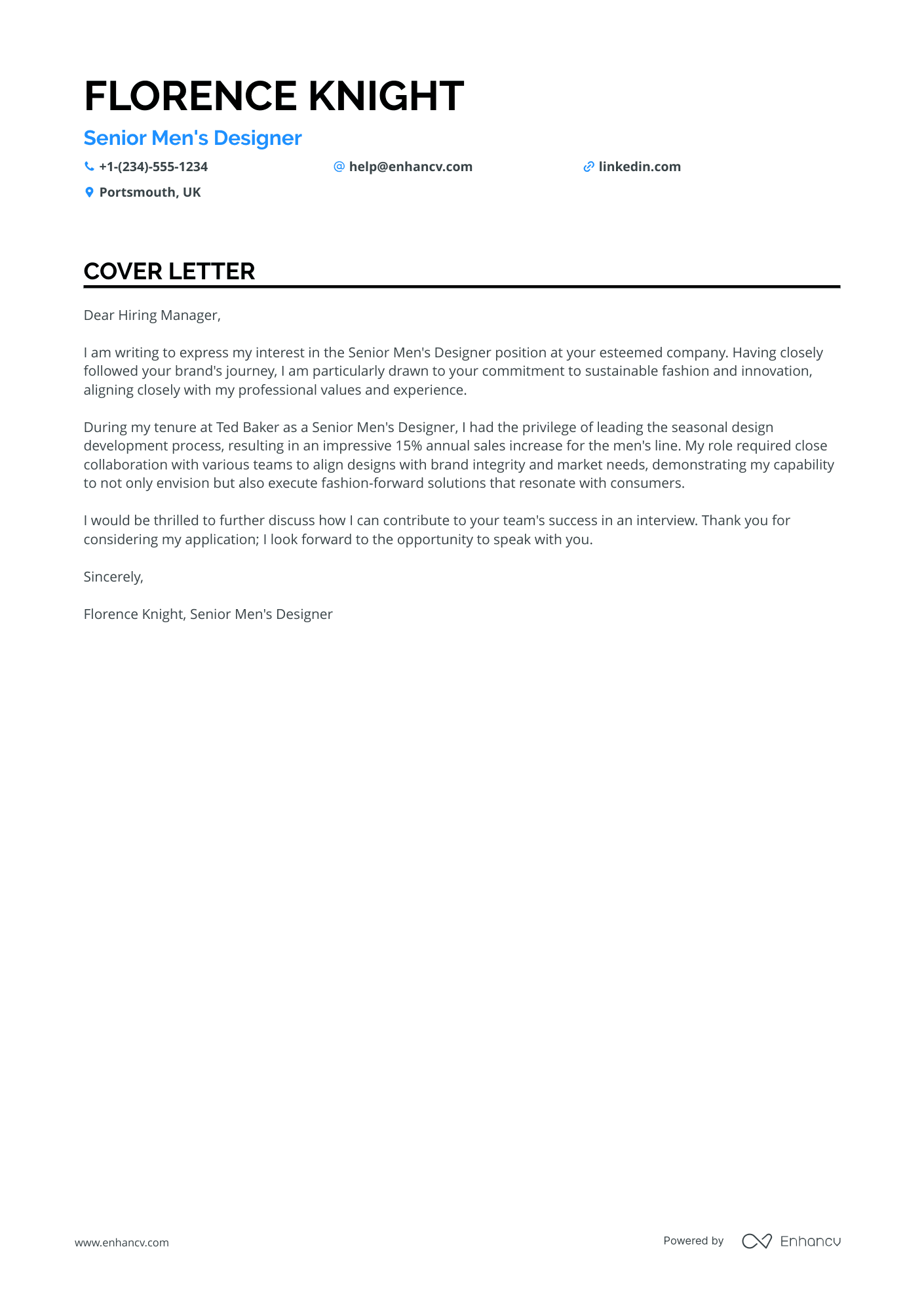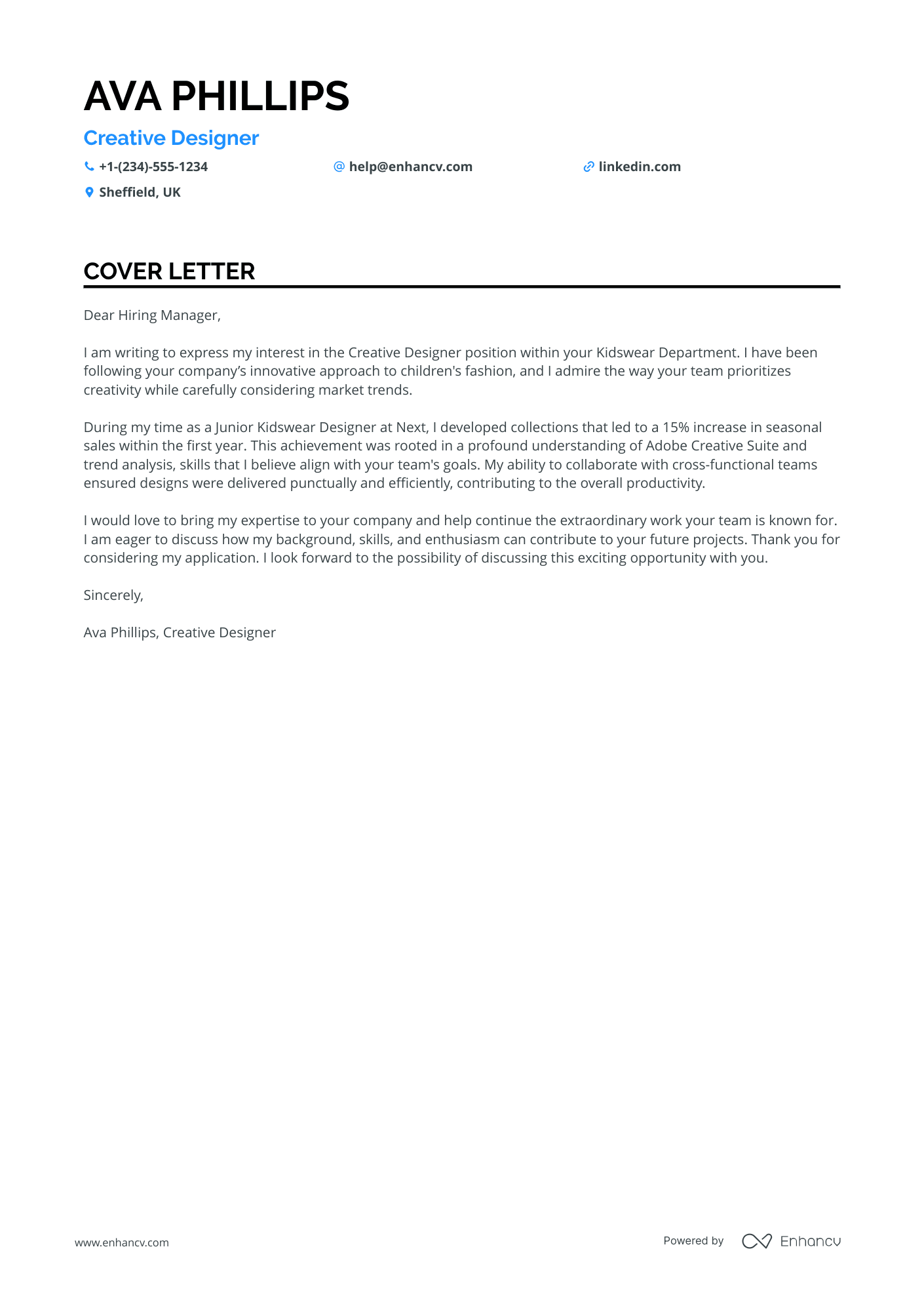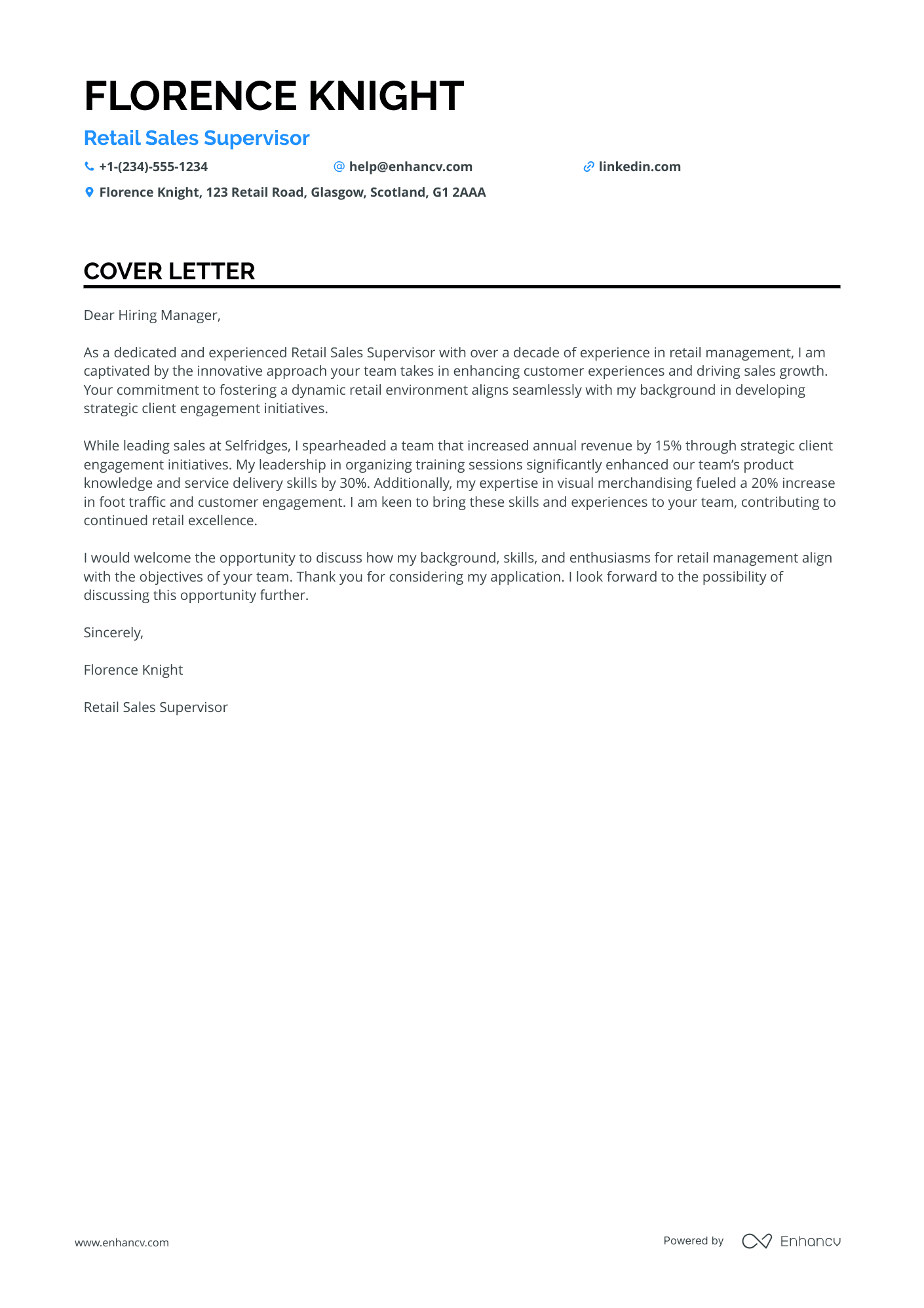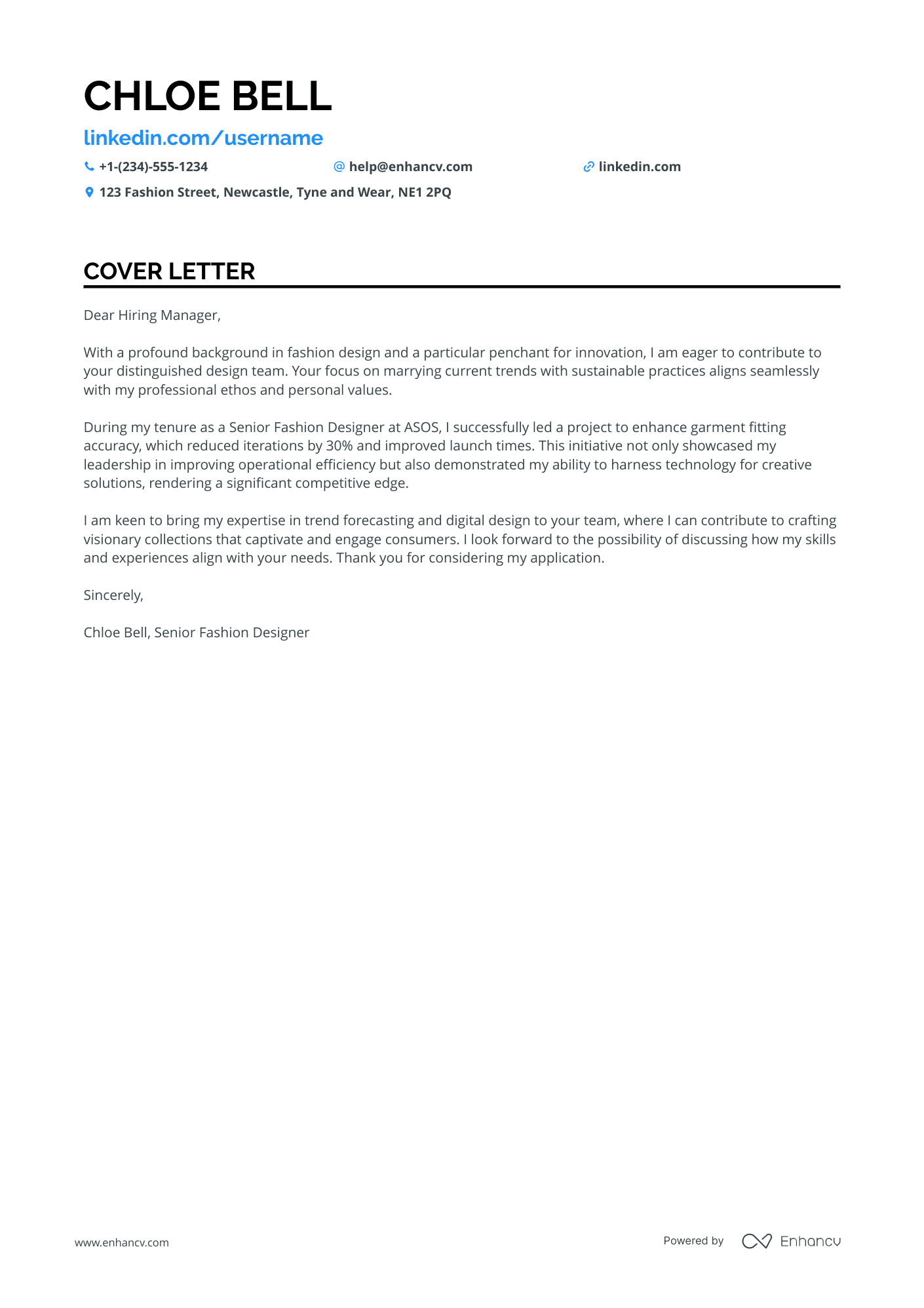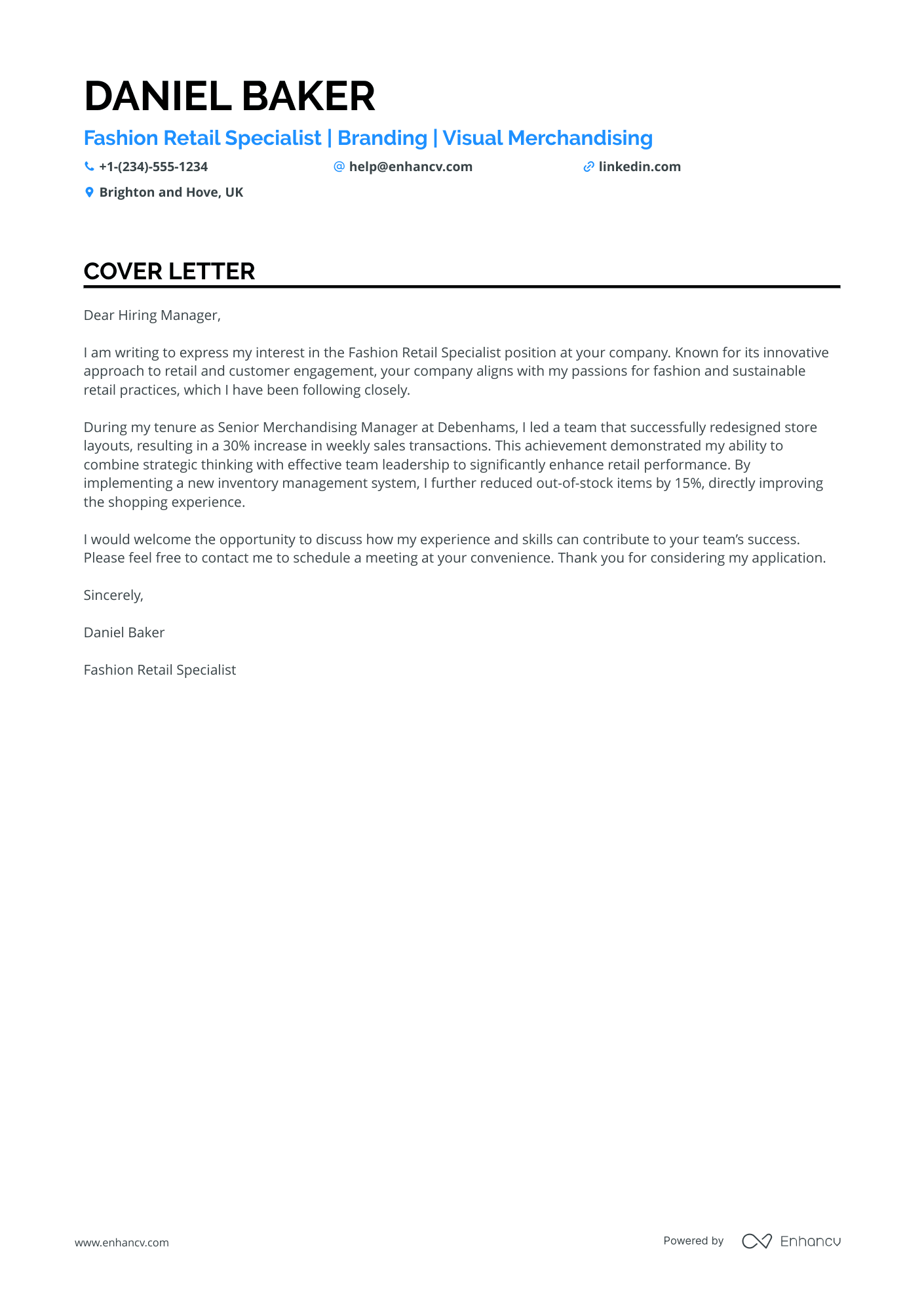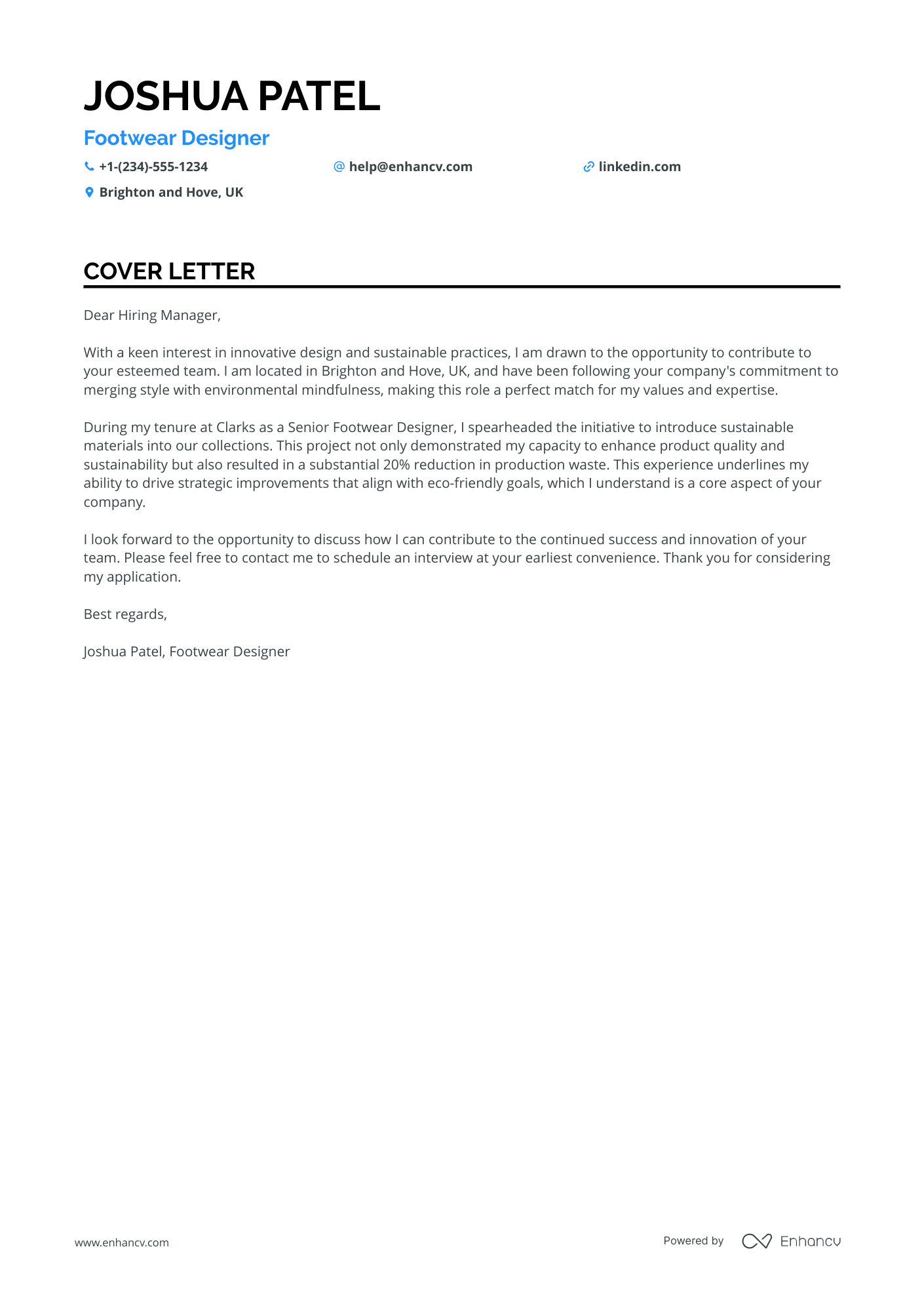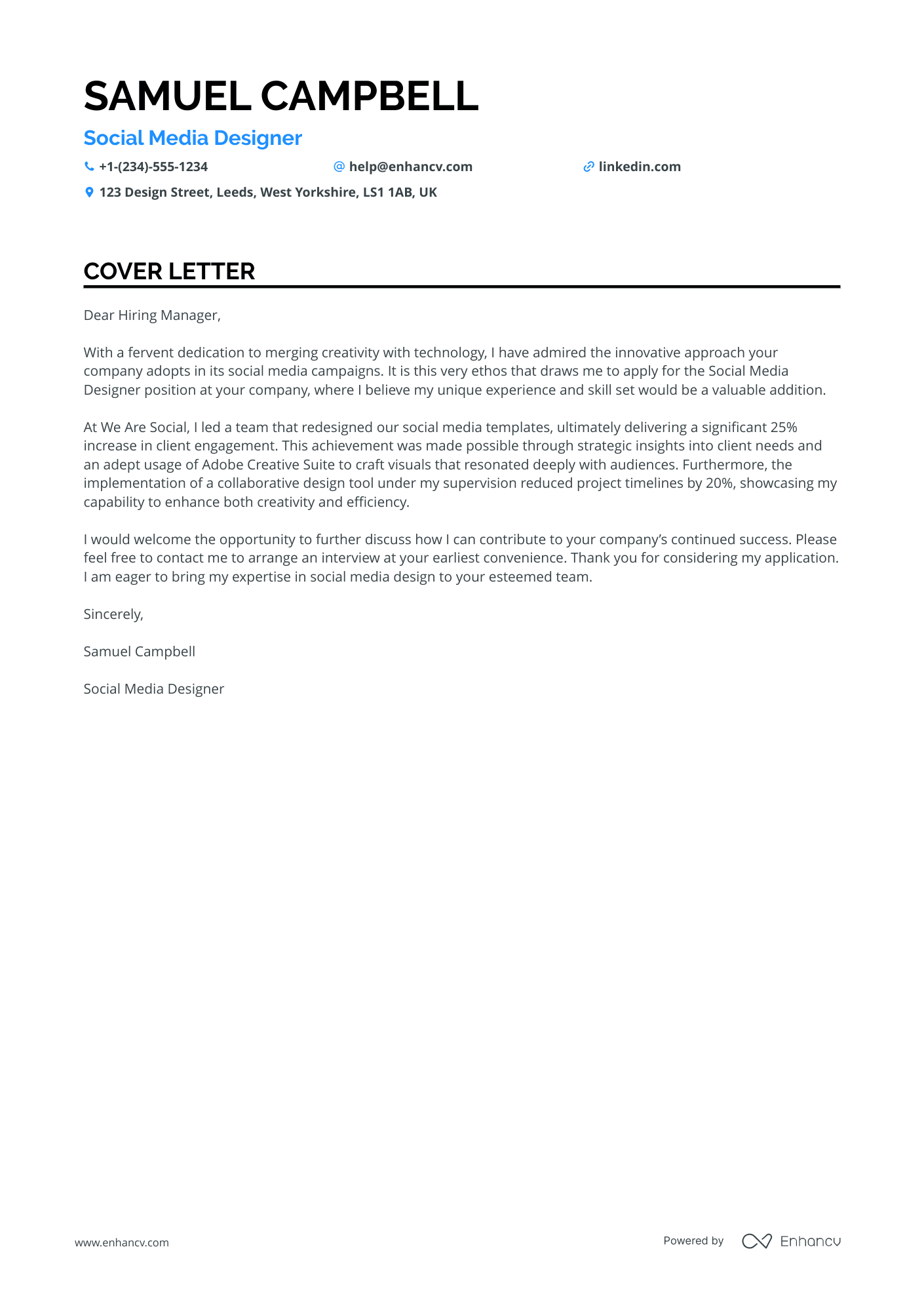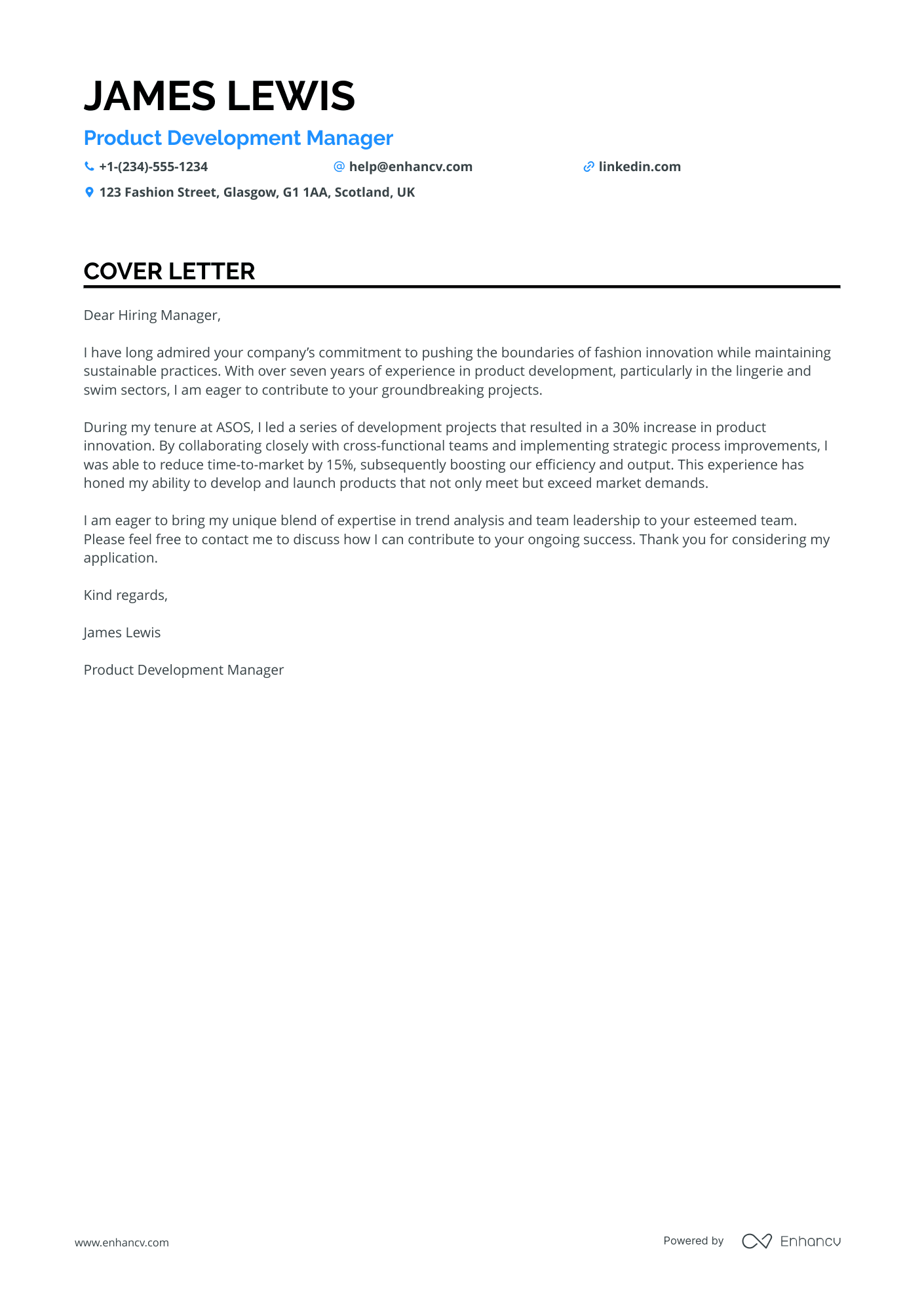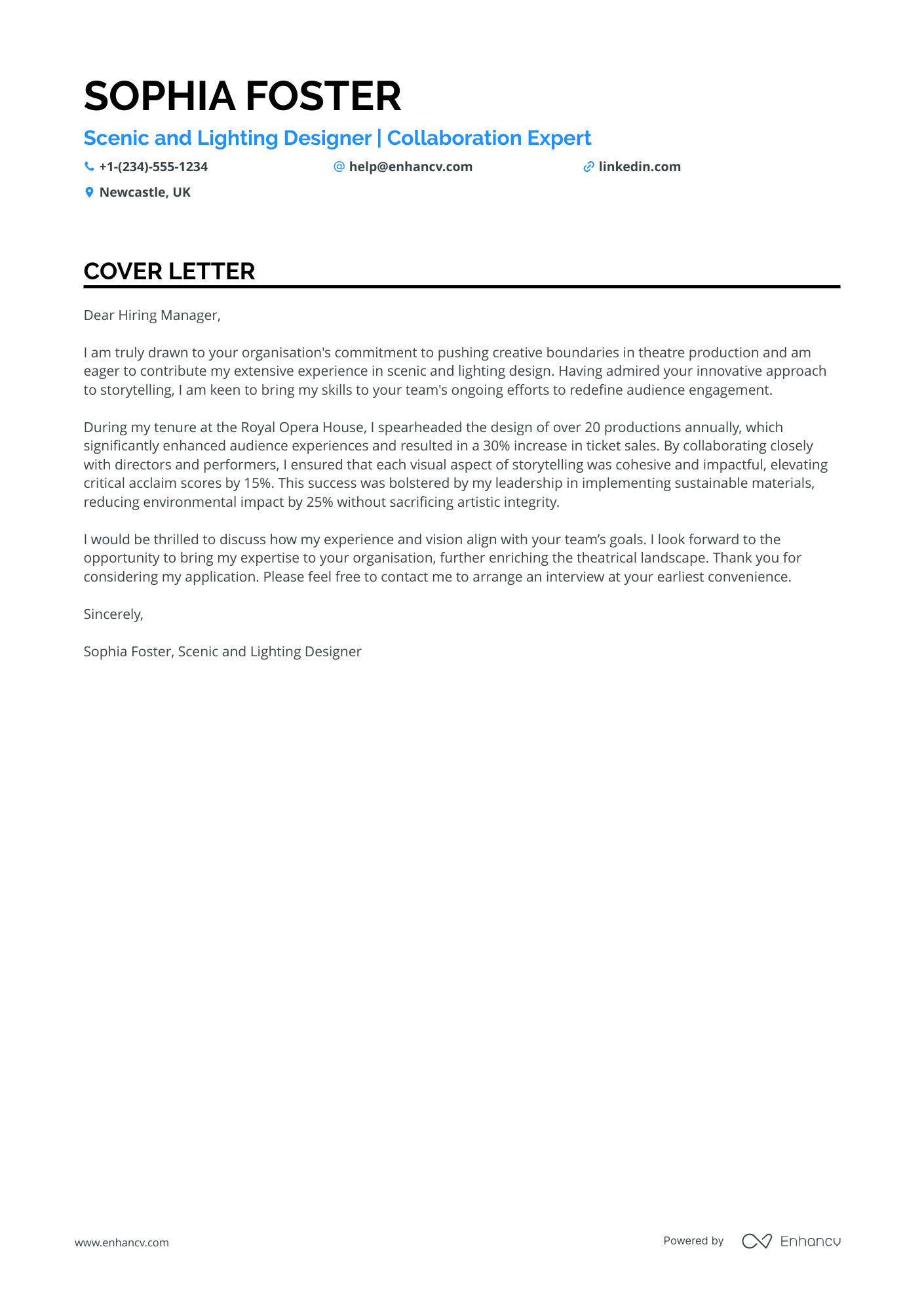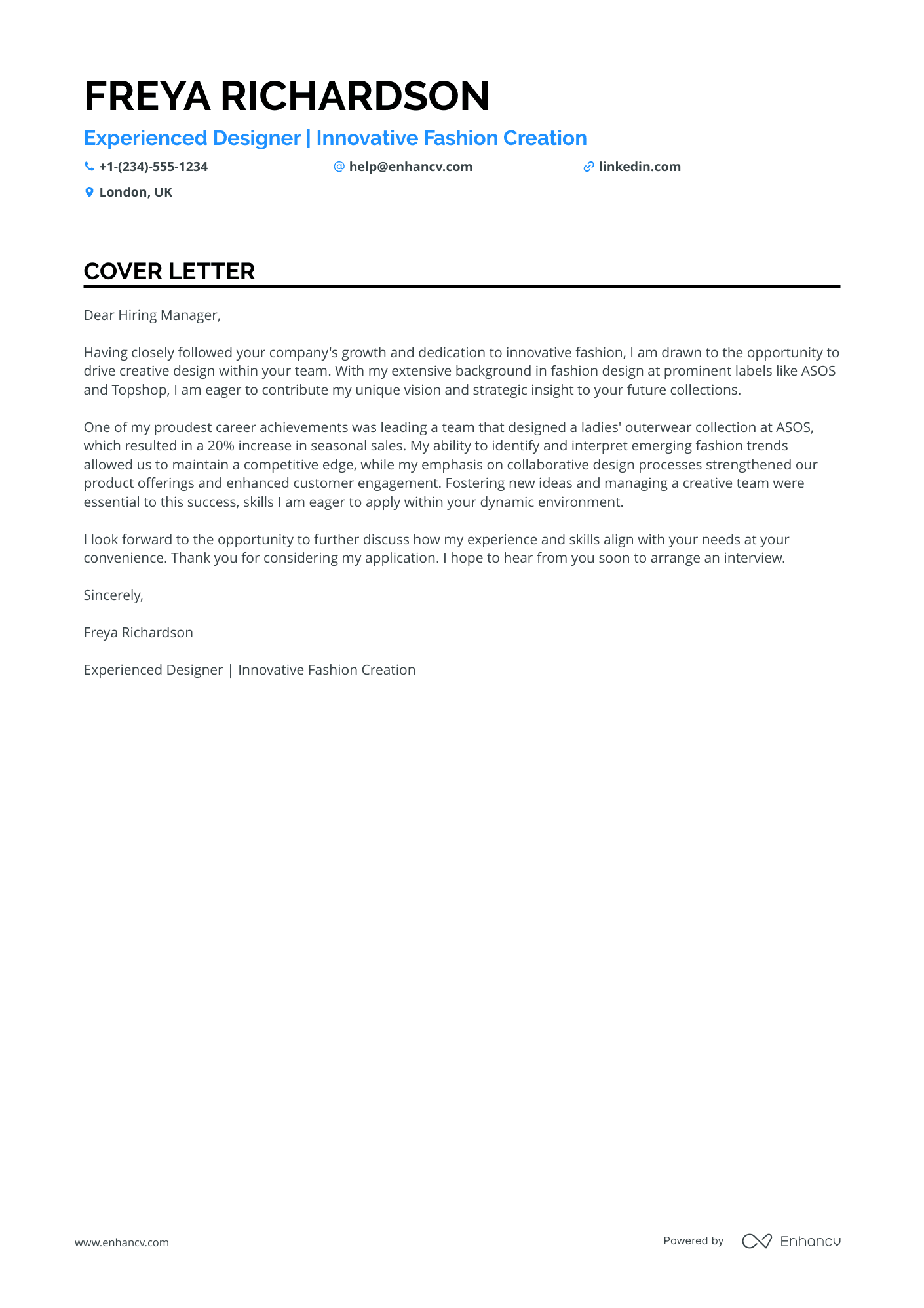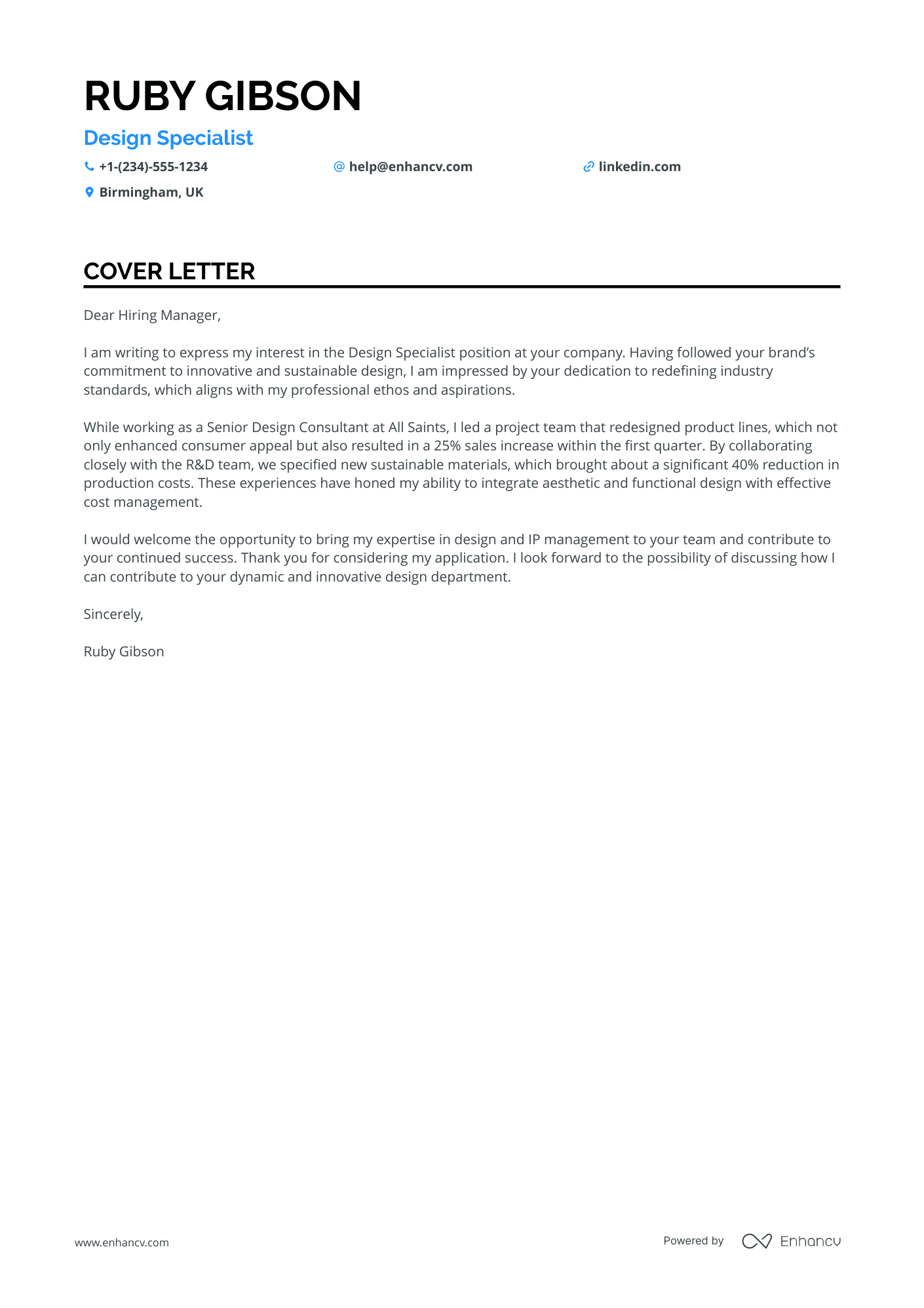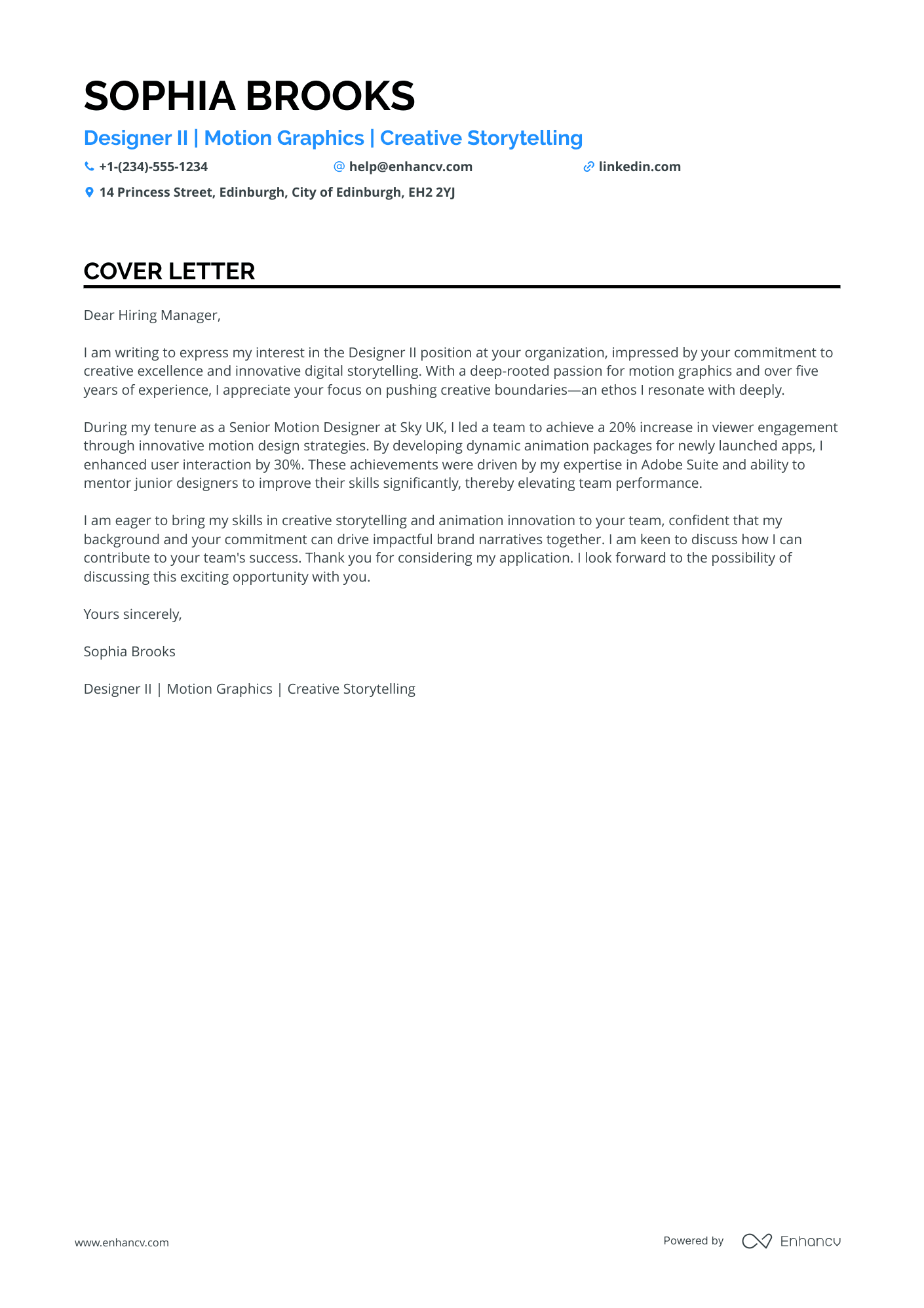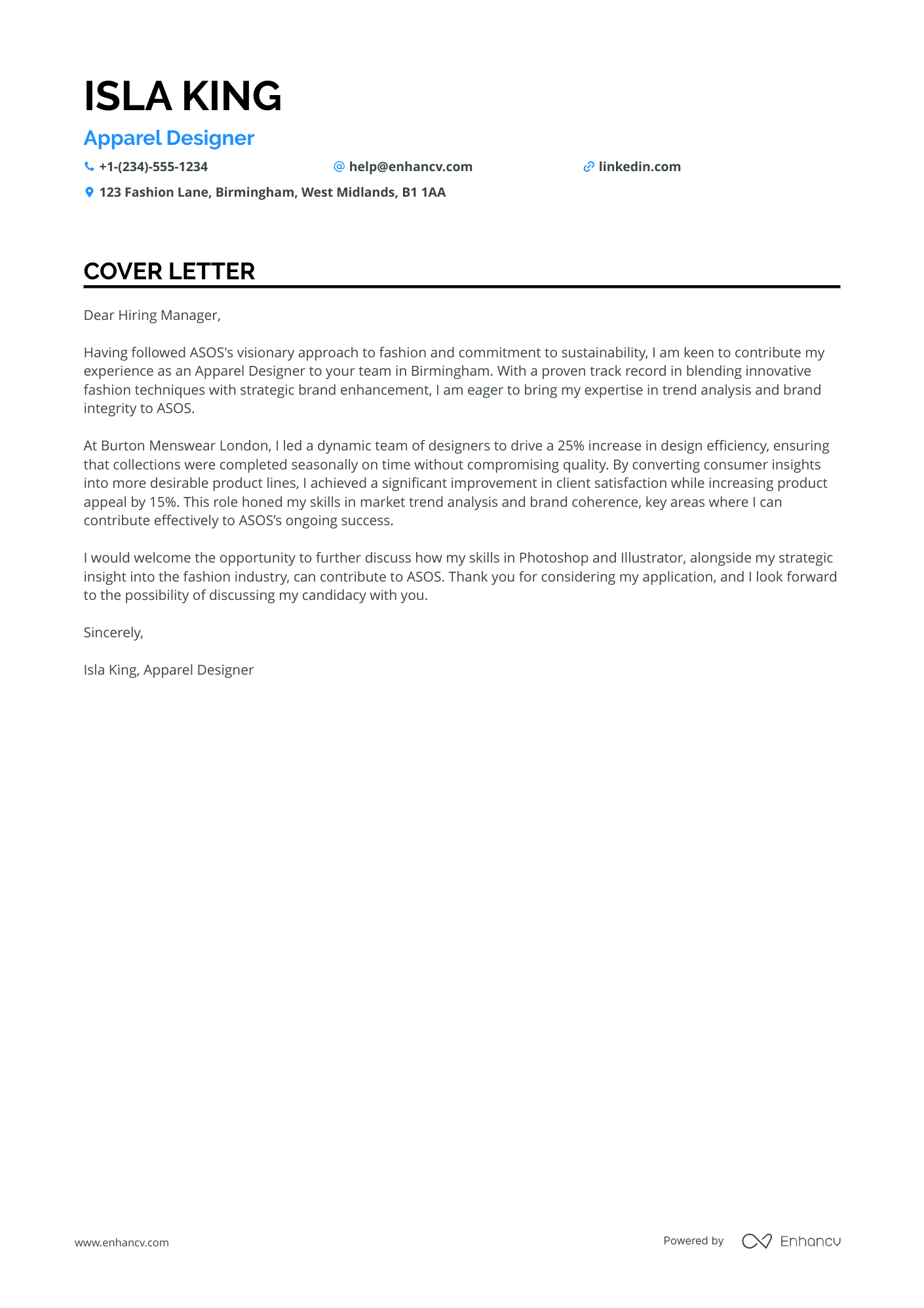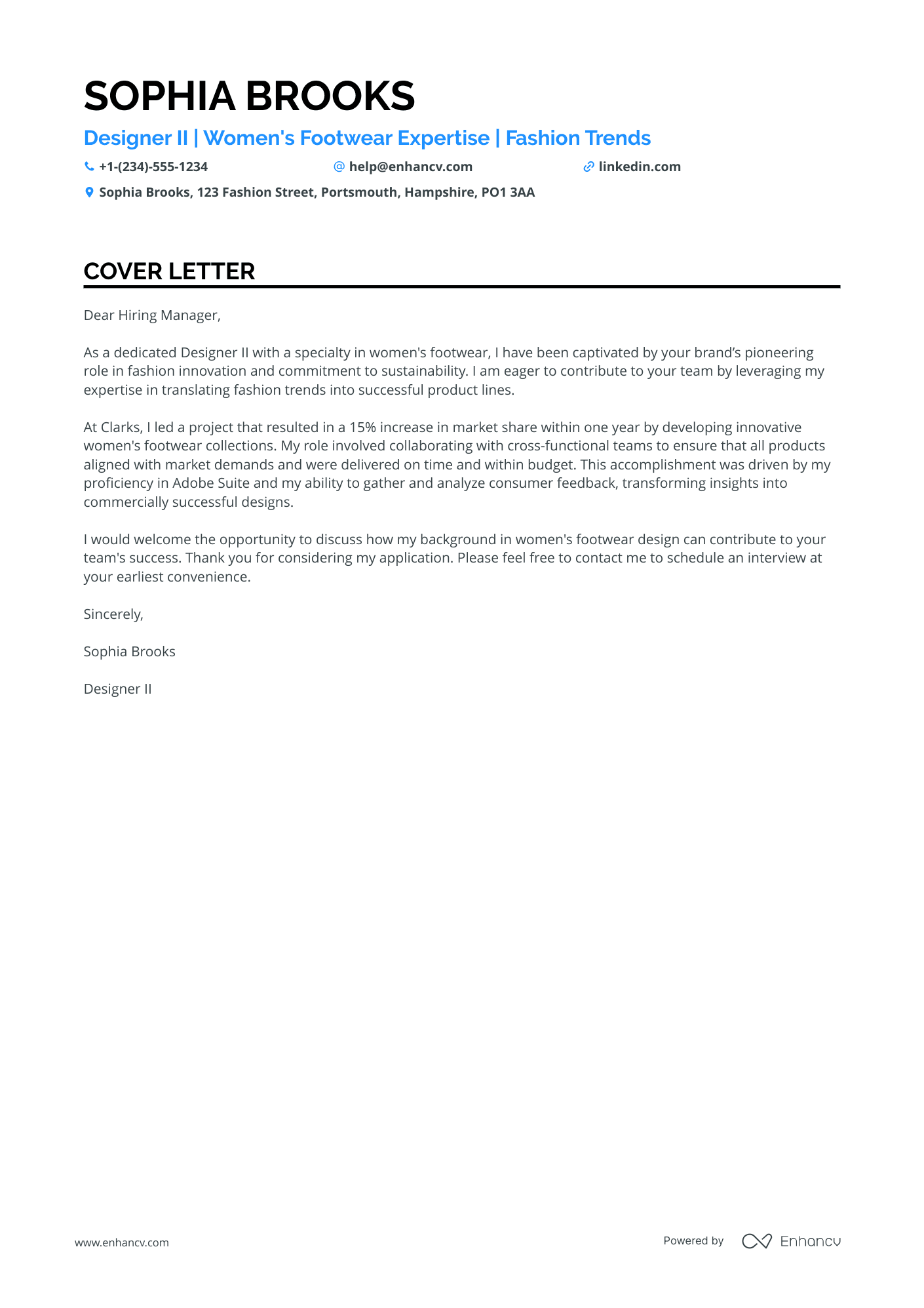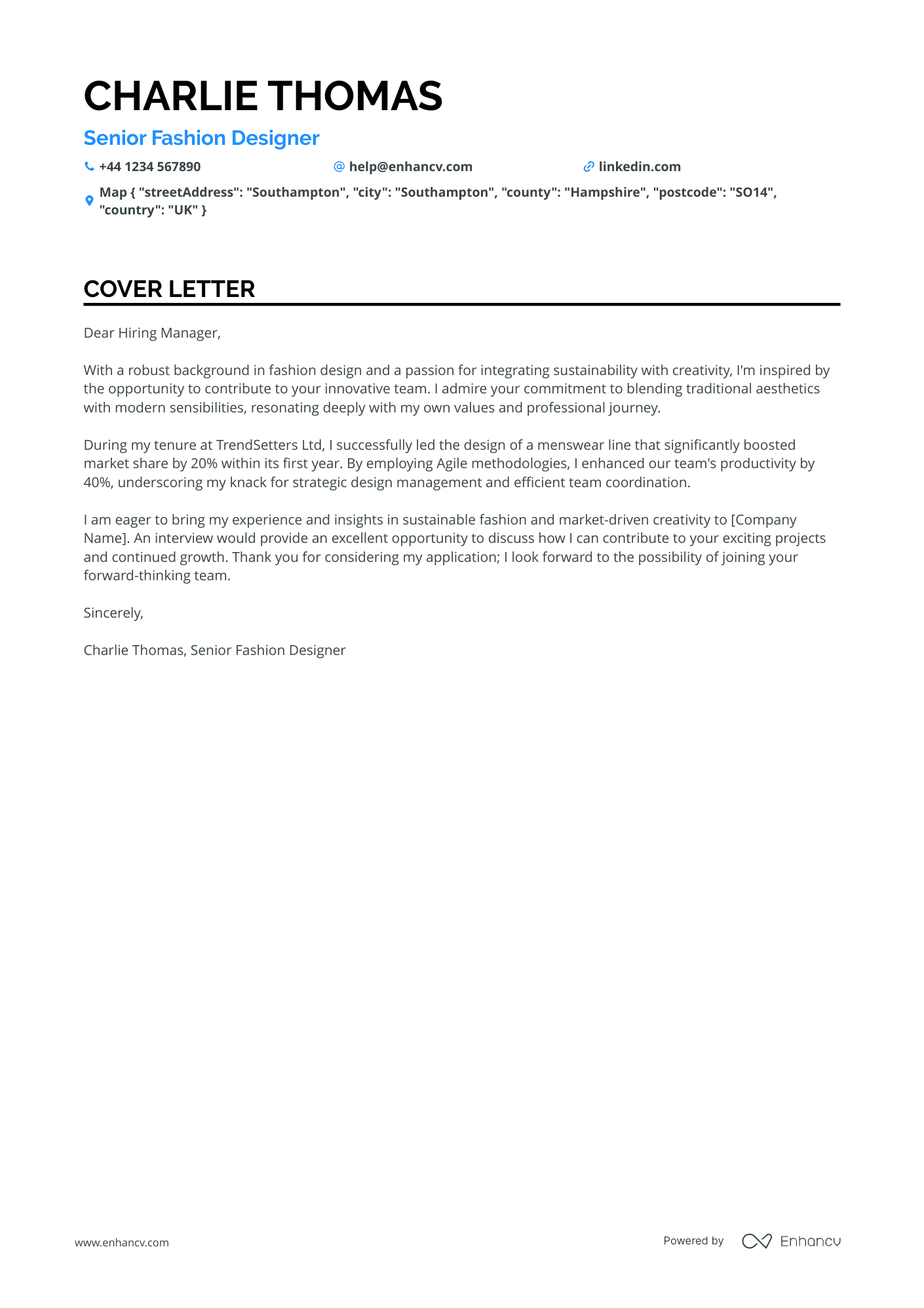You want your cover letter to strike the perfect balance between being professional and showing some personality. But how do you achieve this?
If you write too formally, your tone may come across as stiff. If you're too casual, it may sound overly conversational.
While modesty is always valued, how can you confidently present your skills without sounding arrogant or boastful?
This guide will help you find the right balance, ensuring your cover letter is both professional and personable, while focusing on the key job requirements.
Cover letter examples for fashion designer
By Experience
Junior Fashion Designer
- Highlighting Specific Achievements: The cover letter effectively emphasises accomplishments such as increasing brand engagement by 25% and improving tech pack accuracy by 20%, showcasing the candidate's direct contributions to company success.
- Emphasising Relevant Experience: With roles at renowned fashion houses like Burberry and Alexander McQueen, the letter connects the candidate's experience directly with industry-relevant skills, enhancing credibility for the menswear designer role.
- Skills and Education Alignment: The letter aligns a strong educational background with relevant skills such as Adobe Illustrator proficiency and technical drawing, which are critical for a junior designer position.
- Introducing a Personal Touch: The inclusion of personal passions such as sustainable fashion, contemporary art, and cultural exploration adds depth to the candidate's profile and aligns with modern design values in the industry.
Senior Fashion Designer
- Highlight the advanced digital design techniques and sustainable fashion strategies courses, showcasing a commitment to continuous learning and eco-friendly practices, which are important in the fashion industry.
- Detail impactful achievements like boosting knitwear sales by 30% and reducing production costs by 20%, demonstrating a proven track record of enhancing profitability and efficiency.
- Emphasise leadership capabilities and mentoring skills by outlining the successful guidance of junior designers, which resulted in a 40% increase in team productivity.
- Include specific technical skills such as CAD and Adobe Illustrator proficiency, along with trend analysis, which are essential tools for a Senior Knitwear Designer role.
Assistant Fashion Designer
- Experience Highlight: Highlighting over 6 years of experience in footwear design and demonstrating successful projects with a track record such as increasing sales by 30% with trendsetting designs sets a strong foundation for expertise.
- Technical Skills Emphasis: Mentioning skills like proficiency in Photoshop, Adobe Illustrator, and CAD Software showcases the applicant's technical capabilities crucial for a design role.
- Quantifiable Achievements: Including specific achievements with quantifiable results, such as leading a team that achieved a 25% increase in sales, helps demonstrate the impact and results of the applicant's work.
- Awards and Recognition: Featuring awards like the ‘Best Trendsetting Design Award’ and acknowledgment from Vogue provides external validation of the applicant's calibre and recognition in the industry.
Lead Fashion Designer
- Industry Experience: The cover letter effectively highlights Olivia's over 5 years of experience in fashion design, specifically mentioning her skills in Illustrator and Photoshop, which are crucial tools in the industry.
- Role-Specific Achievements: The cover letter mentions role-specific achievements such as leading a sustainable fabric initiative and developing successful seasonal collections, demonstrating her impact and leadership in previous positions.
- Skills and Tools: There is a clear emphasis on relevant skills such as tech pack creation, trend analysis, and product development, which are critical for the role of a fashion designer.
- Education and Continuing Development: The inclusion of advanced courses in fashion illustration and digital pattern design highlights Olivia's commitment to continuous learning and skill enhancement, which is vital in a rapidly evolving field like fashion design.
By Role
Fashion Designer for Luxury Brands
- Emphasising the strategic planning and execution of exhibitions highlights the candidate's ability to increase museum footfall, which is crucial for roles focused on audience engagement and collection expansion.
- Detailing collaboration with luxury brand stakeholders to secure loans demonstrates the candidate's focus on cultivating high-value partnerships, essential for a curator working with exclusive or luxury collections.
- Crediting the implementation of digital cataloguing systems showcases the candidate's capability to enhance operational efficiency and modernise collection management, which is vital in contemporary museum practices.
- Highlighting achievements in staff training and compliance underlines the candidate's commitment to maintaining high conservation standards, ensuring the longevity and preservation of the collection.
Fashion Designer for Women's Wear
- Emphasising specific sector experience, such as the mention of 4 years in luxury RTW fashion, showcases industry relevance and expertise, which is crucial for high-profile fashion roles.
- Highlighting proven successes with quantitative metrics, like the 25% sales increase achieved through leading collection launches, effectively communicates the candidate's impact and value.
- Showcasing leadership and cross-functional collaboration experiences, such as directing design teams and facilitating workshops, positions the candidate as a capable leader in creative environments.
- Including specialised skills like digital illustration tools and sustainable design initiatives reflects both technical proficiency and adaptability to modern fashion industry trends.
Fashion Designer for Men's Wear
- Relevant Experience & Achievements: The letter effectively highlights Florence's senior role at Ted Baker where she led a design process that boosted sales by 15% annually, displaying her direct impact on commercial success, which is valuable for a Senior Men's Designer role.
- Technical Skills & Certifications: Florence’s advanced proficiency in Adobe Suite is corroborated by a distinction-earning course at Central Saint Martins, which is critical for fashion design roles that rely heavily on digital illustration.
- Education Aligned with Industry Requirements: Holding a Masters from the University of the Arts London positions Florence well within the industry, demonstrating her formal education in fashion design, which is a cornerstone for credibility in senior design roles.
- Passion for Niche Market: Her passion for ‘Coastal Lifestyle’ and its integration into design provides a unique cultural relevance to her work, which can resonate well with brands interested in niche or lifestyle-centred collections.
Fashion Designer for Kidswear
- Specialised Experience: The cover letter highlights Ava's experience in kidswear design, emphasising her previous roles at companies renowned for their children’s clothing lines, showcasing her industry-specific expertise.
- Key Achievements: Ava effectively notes significant accomplishments, such as enhancing sales by 15% and increasing brand visibility by 20%, which illustrate her tangible impact on past employers and her potential value to future teams.
- Relevant Skills and Courses: The emphasis on proficiency in Adobe Creative Suite and completion of relevant courses, such as Kidswear Design Essentials, underscores Ava’s specific technical skills suited to the role.
- Market Trend Analysis: Ava's commitment to conducting market research and identifying trends ensures she remains at the cutting edge, an essential quality for a Creative Designer who must anticipate and respond to changes in fashion.
Fashion Designer for Sportswear
- Highlighting Specific Achievements: Florence effectively highlights specific achievements in previous roles, such as boosting annual sales revenue by 15% at Selfridges and achieving a 92% customer satisfaction rate. These quantifiable results demonstrate her capability in retail management and customer engagement.
- Relevant Industry Skills and Certifications: The cover letter details key skills such as retail management, visual merchandising, and sales forecasting, coupled with relevant certifications like Advanced Retail Management and Certified Visual Merchandiser, showcasing her specialised expertise.
- Strategic Team Leadership: Florence successfully emphasises her leadership abilities by noting how she led a sales team to improve performance and actively engaged in training and development, significantly enhancing team competency.
- Professional Experience with Impact: By describing her experience in managing substantial store turnover and driving effective stock management procedures, Florence underscores her competency in managing large scale retail operations with a strategic and analytical approach.
Fashion Designer for Sustainable Clothing
- Highlighting Relevant Experience: The cover letter effectively emphasises Chloe Bell's substantial experience in high-profile fashion companies such as ASOS and Burberry, showcasing her career progression and leadership roles that align with a senior fashion designer position.
- Specific Achievements: The inclusion of quantifiable achievements, like reducing garment fitting iterations by 30% and increasing seasonal collection success rate by 22%, provides concrete evidence of Chloe's impact and value in her previous roles.
- Emphasis on Skills and Certifications: The letter specifically mentions skills crucial to the role, such as garment technology, digital design tools, and trend forecasting. Certifications from well-known institutions like Central Saint Martins further testify to Chloe's expertise and commitment to her craft.
- Passion and Personal Interests: Including passions such as exploring fashion trends and sustainable living adds a personal touch, demonstrating Chloe's dedication to her profession and values that align with contemporary industry trends.
Fashion Designer for Accessories
- Emphasise Quantifiable Achievements: Highlight specific achievements with measurable outcomes, like the 30% boost in weekly sales or £250,000 revenue from seasonal campaigns. This showcases effectiveness and impact in previous roles.
- Showcase Leadership and Team Management: Mention the experience of leading teams, implementing successful employee training programs, and mentoring, which are critical for managerial roles in fashion retail.
- Highlight Relevant Certifications and Courses: Note specialised courses like "Advanced Fashion Merchandising" and "Digital Marketing in Retail" to demonstrate a commitment to continued professional development and sector-specific expertise.
- Include Passion Projects and Volunteer Work: Reference a dedication to advancing heart health research through volunteering, demonstrating a well-rounded character and community involvement.
Fashion Designer for Footwear
- Highlighting Key Achievements: The cover letter effectively underscores significant achievements such as leading a sustainable materials initiative that reduced production waste by 20% at Clarks, showcasing the candidate's innovative and environmentally conscious approach.
- Specific Role Experience: It outlines relevant job experiences, emphasising the candidate's senior role at Clarks where they led the development of high-end men's footwear collections and increased sales revenue by 15%.
- Education and Professional Development: The cover letter showcases advanced education relevant to the footwear design field, including a Master of Arts in Design, Fashion, and Footwear from the London College of Fashion, as well as targeted courses like 'Advanced Footwear Design Techniques'.
- Showcasing Leadership and Team Skills: The mention of conducting workshops with junior designers to increase team productivity by 25% reflects strong leadership abilities and a commitment to team development.
Freelance Fashion Designer
- Highlighting specific achievements and metrics, such as the 25% boost in client engagement from redesigning social media templates, effectively demonstrates the candidate's impact and success in driving tangible results.
- Emphasising proficiency in Adobe Creative Suite underscores essential technical skills and expertise in tools critical for designing compelling social media visuals, which is vital for a Social Media Designer role.
- Incorporating notable project achievements, such as leading a campaign redesign that improved client online engagement by 25%, showcases leadership and strategic capabilities relevant to the position.
- Detailing language proficiency, particularly in English at a professional level, is beneficial in highlighting strong communication skills necessary for collaborating with international clients and teams.
Fashion Designer for Lingerie and Swimwear
- Highlighting and quantifying achievements: Emphasise accomplishments such as boosting sales by 25% through successful product launches, which demonstrates a tangible impact on the business.
- Industry-specific skills and experience: Emphasise skills such as fashion trend analysis, vendor negotiation, and garment construction, which are crucial for a Product Development Manager in fashion.
- Leadership capabilities: Mention mentoring achievements, like improving team performance by 20%, to demonstrate your ability to lead and manage a team effectively.
- Focus on innovation and efficiency: Mentioning process optimisations, such as reducing product development timelines by 20%, showcases your capability to drive improvements and value within the organisation.
Fashion Designer for Bridal Wear
- Emphasises experience and achievements in scenic and lighting design, which are crucial for roles in theatre production, demonstrating the impact through increased ticket sales and critical acclaim scores.
- Highlights advanced skills and innovative contributions to sustainability in theatre design, a valued aspect in modern production practices.
- Showcases leadership and collaboration skills, evidenced by team management and workshop facilitation, important for success in a collaborative creative environment.
- Includes relevant certifications and awards, such as the UK Theatre Award for Best Scenic Design and Lighting Innovation Award, providing credibility and recognition in the industry.
Fashion Designer for Outerwear
- Highlight Relevant Experience: The cover letter showcases extensive industry experience with well-known fashion brands like ASOS, Topshop, and River Island, emphasising leadership and creative contributions that increased market share and sales.
- Use of Quantifiable Achievements: Achievements are quantified (e.g. “20% increase in seasonal sales”, “25% increase in net sales”), which effectively demonstrates the candidate's impact and success in previous roles.
- Listing Market-Relevant Skills and Certifications: The letter aligns with the fashion design role by listing pertinent skills such as fashion design, trend forecasting, Adobe Creative Suite, and certifications from the Fashion Institute of Technology and Central Saint Martins.
- Emphasis on Fashion Innovation and Sustainability: By mentioning passions for fashion innovation and sustainable fashion, the cover letter highlights alignment with current industry trends and values, potentially appealing to forward-thinking employers.
Fashion Designer for Evening Wear
- Relevant Experience: Highlighting specific projects, like redesigning product lines to boost sales and collaborating with R&D on sustainable materials, underscores your practical experience and impact in the design sector.
- Skill Emphasis: Including valued skills such as 'Intellectual Property Management' and 'Material Specification' prominently as these are crucial for roles involving innovation and design protection.
- Certifications and Courses: Showcasing courses such as 'Intellectual Property for Designers' from Coursera highlights your commitment to staying informed about industry best practices and legal aspects of design.
- Achievements and Awards: Mentioning awards like the 'Design Innovation Award 2018' demonstrates recognition from peers and industry, validating your innovative capabilities and success in sustainable design.
Fashion Designer for High Street Brands
- Emphasising specialised skills in motion graphics and Adobe Suite helps establish expertise in creative storytelling and designing visually compelling content.
- Highlighting a proven track record of increasing viewer engagement and user interaction through past projects fortifies the candidate's ability to contribute positively to the company's objectives.
- Illustrating the ability to collaborate effectively with cross-functional teams and mentor junior designers demonstrates strong leadership and teamwork skills, crucial for advancing in a Designer II role.
- Showcasing relevant certifications, such as the "Adobe Certified Expert" and completing courses like "Advanced Motion Graphics Techniques", offers added credibility to the applicant's proficiency in current industry-standard tools and methods.
Fashion Designer for Custom Clothing
- Emphasising Specialised Experience: The cover letter highlights over three years of experience specifically within lifestyle brands, which is crucial for an Apparel Designer role focused on market trends.
- Showcasing Key Achievements: The inclusion of quantitative achievements such as a 25% increase in design efficiency and a 30% improvement in garment fit satisfaction effectively demonstrates capability and impact.
- Integration of Market Trends and Consumer Insights: Describing efforts in transforming consumer insights into appealing product lines, and researching global markets to introduce innovative fabric techniques, showcases the ability to align design with current trends and consumer needs.
- Highlighting Sustainability Efforts: The mention of integrating sustainable materials and achieving cost reductions supports an alignment with current industry shifts towards sustainability, which is a growing expectation in apparel design leadership roles.
Fashion Designer for Couture
- Detailed Achievements: Sophia's cover letter effectively highlights her significant professional accomplishments, such as leading a project that resulted in a 15% increase in market share for Clarks. This kind of specificity demonstrates her capability in her field.
- Relevant Skills and Certifications: The cover letter includes pertinent skills like Adobe Suite proficiency and 3D design programs, which are crucial for a role in women's footwear design. Additionally, certifications like "3D Footwear Design" from Arsutoria School provide credibility to her technical expertise.
- Passion for Industry Trends: By discussing her passions, such as sustainable fashion and travel, Sophia reveals her dedication to staying ahead of industry trends and integrating them into her innovative designs, which can be appealing to potential employers.
- Leadership and Collaboration: The cover letter underscores Sophia's leadership abilities through her role in mentoring junior designers and improving team performance, as well as her collaboration with cross-functional teams, highlighting her versatility and team-oriented approach.
Fashion Designer cover letter example
Charlie Thomas
[object Object]
+44 1234 567890
help@enhancv.com
- Clearly highlight relevant experience: Specify achievements, such as leading a successful menswear line that increased market share by 20%, which demonstrates impact and qualifications for a fashion designer role.
- Use industry-specific methodologies: Mention Agile methodologies, as they indicate advanced project management skills and efficiency, which are valuable in team and design management roles.
- Align personal values with company values: Express passion for sustainability and creativity, aligning with the company's ethos, which can strongly resonate with prospective employers.
- Quantify achievements: Use specific percentages and figures (e.g., increased productivity by 40%) to showcase tangible results from past roles, offering concrete evidence of one's capabilities.
Importance of cover letters in the United Kingdom
Cover letters provide recruiters with the opportunity to learn more about your career aspirations, hinting at how you’d integrate within the organisation over the long term.
Here are three additional reasons why cover letters are important:
- Making an excellent first impression (and a formal introduction): Your cover letter is often the employer’s first introduction to you, showcasing your personality, communication skills, and motivation for the role.
- Complementing your career history: While your CV lists qualifications and experience, a cover letter provides the context, explaining how your background fits the role.
- Demonstrates your genuine interest: A well-crafted cover letter reflects the effort you’ve put into researching the company and role as well as your attention to detail.
What UK employers expect from a cover letter
A great cover letter can set you apart when applying for jobs in the UK.
Follow these tips to ensure you make a strong impression:
- Research thoroughly: Spend time delving into the company’s website, social media, and industry news to understand their projects, awards, and future plans. The more specific your knowledge, the better you’ll be able to demonstrate your suitability for the role.
- Reflect their values: Every UK company has its own set of values that guides their culture. Once you’ve identified them, make sure your cover letter reflects how your values and work ethic align with theirs. If they’re known for integrity, emphasise your commitment to ethical practices.
- Tailor your skills: Focus on aligning your most relevant skills with the job description. Look for key terms and priorities mentioned in the advert, and make sure to provide examples of how you excel in those areas.
How to format a fashion designer cover letter
Your cover letter is your opportunity to make a strong impression, so its structure must be professional and clear.
Here's an overview of how a UK cover letter should be structured:
- Begin with your address and contact details at the top.
- Include the employer’s name and address directly below.
- Add the date to the left or right of the page.
- Use an appropriate greeting, such as 'Dear Mr Smith' or 'Dear Sir/Madam.'
- Open with a strong introductory paragraph.
- Develop your points in the middle paragraphs, focusing on relevant skills and experience.
- Close with a concise conclusion, reiterating your interest and suitability for the role.
- Sign off formally with your name and signature.
The software used to match your profile to the job, Applicant Tracking Systems (ATS), won’t scan your cover letter. Instead, the cover letter reads as a more personalised note to the recruiter.
When it comes to choosing a font, consider modern options like Lato, Rubik, or Chivo, which should also be applied to your CV to maintain a consistent appearance.
Additionally, your cover letter should be single-spaced with 1-inch (2.5 cm) margins on all sides (our templates are pre-set with these specifications so you can focus on your cover letter content).
Finally, always send your cover letter as a PDF to preserve the formatting and prevent edits.
How to write your fashion designer cover letter salutation
It's never advisable to begin your cover letter with 'Dear Sir/Madam', as it sounds comes across as impersonal.
Take the time to find out who is hiring for the role and address them directly in your cover letter greeting (e.g., 'Dear Mrs Chanceworth', 'Dear Harrod').
If you're uncertain where to find the hiring manager’s name, check the company website, look on LinkedIn, or send a courteous email requesting this information. Don't hesitate to ring reception either—they are unlikely to refuse to assist.
How to write your fashion designer cover letter intro
It's never a bad time to show enthusiasm about the role, company, or team in your cover letter introduction.
Begin by sharing one or two aspects that genuinely excite you about the position—whether it's the company culture, specific responsibilities, or the team's past achievements.
Your enthusiasm demonstrates that you'll bring a strong work ethic, are eager to contribute, and are motivated to succeed.
How to write your fashion designer cover letter body
Which makes for a stronger cover letter body: a long-winded account of everything you’ve ever done, or a focused achievement that’s directly relevant to the job?
Hint: recruiters prefer the second.
When writing your cover letter, select your most impressive achievement that:
- Directly aligns with the job description and role.
- Is quantifiable with tangible metrics like numbers or percentages.
- Maps out your hard and soft skills, showcasing what makes you unique.
- Tells the story of the impact you could have on the organisation.
How to write a closing paragraph
Now we’ve reached the closing paragraph of your cover letter. You might be tempted to end with a simple Yours sincerely, but don’t!
Instead, finish with a promise to enhance the company’s performance metrics (backed by your hard and soft skills), to develop as a professional, or something else that holds significance for the organisation. Whatever you choose, ensure to stand behind your words and be remain sincere.
Don’t forget to include a call to action, encouraging recruiters to suggest the best time to follow up for an interview or update.
Conclusion
Your cover letter is an opportunity to showcase your personality and skills to potential employers. Start by addressing the hiring manager by name and tailoring your content to reflect the role’s requirements.
Include a specific example of your greatest achievement to illustrate your suitability for the position, while also expressing your enthusiasm for the company. Remember to format your letter professionally, ensuring it aligns seamlessly with your CV.
